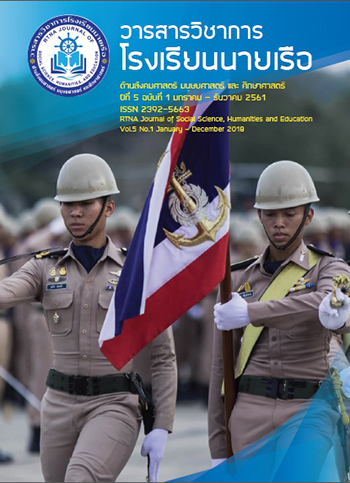การประเมินผลความรู้ ตามมาตรฐานวิชาชีพทหารเรือของกองทัพเรือในด้านการเดินเรือและนำเรือของนักเรียนนายเรือชั้นปีที่ 5 พรรคนาวิน ปีการศึกษา 2560
บทคัดย่อ
ในปัจจุบันโรงเรียนนายเรือยังไม่ได้ประเมินผลความรู้ด้านวิชาชีพทหารเรือในด้านการเดินเรือและนำเรือก่อนการสำเร็จการศึกษาของนักเรียนนายเรือชั้นปีที่ 5 พรรคนาวิน ทำให้เมื่อนักเรียนนายเรือสำเร็จการศึกษาแล้ว โรงเรียนนายเรือไม่สามารถทราบผลการศึกษาตามหลักสูตรได้ ส่งผลให้โรงเรียนนายเรือขาดข้อมูลการประเมินผลในการปรับหลักสูตร ข้อมูลการจัดการเรียนการสอน และการฝึกที่ชัดเจนเป็นรูปธรรม ดังนั้น การวิจัยนี้มีวัตถุประสงค์เพื่อประเมินผลความรู้ตามมาตรฐานวิชาชีพทหารเรือของกองทัพเรือในด้านการเดินเรือและนำเรือของนักเรียนนายเรือชั้นปีที่ 5 พรรคนาวิน ปีการศึกษา 2560 โดยกระบวนการวิจัยแบ่งออกเป็น 4 ขั้นตอน คือ 1) ศึกษาและวิเคราะห์เนื้อหาความรู้และออกตารางแบบทดสอบ 2) ออกแบบทดสอบความรู้และรูปแบบการทดสอบภาคปฏิบัติ : โดยการประเมินผลความรู้ทั้งหมดมีคะแนนเต็ม 180 คะแนน แบ่งเป็น การประเมินผลความรู้ 120 คะแนน การประเมินผลภาคปฏิบัติผ่านเครื่องฝึกจำลองการเดินเรือ 2 สถานการณ์ ๆ ละ 30 คะแนน รวม 60 คะแนน 3) ตรวจสอบคุณภาพแบบทดสอบความรู้และรูปแบบการทดสอบภาคปฏิบัติ : จากการสัมภาษณ์ความคิดเห็นจากผู้เชี่ยวชาญ 4) ประเมินผลความรู้ นักเรียนนายเรือชั้นปีที่ 5 ปีการศึกษา 2560 และนำผลการสอบมาวิเคราะห์ตามหลักสถิติ จากผลการวิจัยครั้งนี้ ทำให้เราทราบว่านักเรียนนายเรือชั้นปีที่ 5 พรรคนาวิน ปีการศึกษา 2560ได้คะแนนประเมินผลความรู้เฉลี่ยเพียงแค่ร้อยละ 57.51 ไม่ผ่านเกณฑ์ที่กองทัพเรือกำหนดไว้ร้อยละ 70 อาจจะเกิดจากสาเหตุ 2 ประการ ได้แก่ 1) ผลการประเมินครั้งนี้ไม่ส่งผลกับนักเรียนนายเรือชั้นปีที่ 5 แต่อย่างใด ทำให้นักเรียนไม่ได้ทบทวนก่อนการประเมิน 2) นักเรียนนายเรือชั้นปีที่ 5 ขาดทักษะการคิดวิเคราะห์ โดยเฉพาะในวิชาการนำเรือและกฎระเบียบข้อบังคับในการเดินเรือ
เอกสารอ้างอิง
กองทัพเรือ. (ม.ป.ป.). ระเบียบกองทัพเรือ ว่าด้วยหน้าที่ราชการในเรือหลวง พ.ศ.2531. กรุงเทพฯ: กองทัพเรือ.
โกวิทย์ ประวาลพฤกษ์ และสมศักดิ์ สินธุระเวชญ์. (2523). การประเมินในชั้นเรียน. กรุงเทพฯ: ไทยวัฒนาพานิช.
เชิดศักดิ์ โฆวาสินธุ์. (2529). การวัดภาคปฏิบัติ. วารสารมิตรครู. 28 (12), : 16-19.
ธงชัย ชิวปรีชา, ณรงค์ศิลป์ ธูปพนม และปรีชา เดชศรี. (2526). หน่วยที่ 12 การวัดและการประเมินผลการเรียนการสอนวิทยาศาสตร์. เอกสารการสอนชุดวิชา การสอนวิทยาศาสตร์. นนทบุรี: มหาวิทยาลัยสุโขทัยธรรมาธิราช.
บุญธรรม กิจปรีดาบริสุทธ์. (2535). การวัดและการประเมินผลการเรียนการสอน. พิมพ์ครั้งที่ 2. กรุงเทพฯ: มหาวิทยาลัยมหิดล.
พีรศิลป์ อนันยวราคม, รองผู้อำนวยการกองวิชาการเรือและเดินเรือ ฝ่ายศึกษา โรงเรียนนายเรือ. สัมภาษณ์. 7 ธันวาคม 2560.
โรงเรียนนายเรือ. (2558). หลักสูตรการศึกษาโรงเรียนนายเรือ พ.ศ.2558. สมุทรปราการ: โรงเรียนนายเรือ.
โรงเรียนนายเรือ. (2558). หลักสูตรการศึกษาโรงเรียนนายเรือ พ.ศ.2558 (ภาคปฏิบัติ). สมุทรปราการ: โรงเรียนนายเรือ.
Bloom, B. (1956). Bloom et al.'s taxonomy of the cognitive domain.
Educational Psychology Interactive. Valdosta, GA: Valdosta State University.
Keeves, P. J. (1988). Model and Model Building. Educational Research, Methodology, and Measurement: An International Handbook. Oxford: Pergamon Press.
Tuckman, B. W. (1975). Measuring Education Outcome: Fundamentals of Testing. New York: Hascourt Brace Jobanovich.
ดาวน์โหลด
เผยแพร่แล้ว
ฉบับ
ประเภทบทความ
สัญญาอนุญาต
เนื้อหาและข้อมูลในบทความที่ลงตีพิมพ์ในวารสารวิชาการโรงเรียนนายเรือ ด้านสังคมศาสตร์ มนุษยศาสตร์ และ ศึกษาศาสตร์ ถือเป็นข้อคิดเห็นและความรับผิดชอบของผู้เขียนบทความโดยตรง ซึ่งกองบรรณาธิการวารสาร ไม่จำเป็นต้องเห็นด้วย หรือร่วมรับผิดชอบใด ๆ
บทความ ข้อมูล เนื้อหา รูปภาพ ฯลฯ ที่ได้รับการตีพิมพ์ในวารสารวิชาการโรงเรียนนายเรือ ด้านสังคมศาสตร์ มนุษยศาสตร์ และ ศึกษาศาสตร์ ถือเป็นลิขสิทธิ์ของโรงเรียนนายเรือ หากบุคคลหรือหน่วยงานใดต้องการนำทั้งหมดหรือส่วนหนึ่งส่วนใดไปเผยแพร่ต่อหรือเพื่อกระทำการใด ๆ จะต้องได้รับอนุญาตเป็นลายลักษณ์อักษร จากโรงเรียนนายเรือก่อนเท่านั้น






